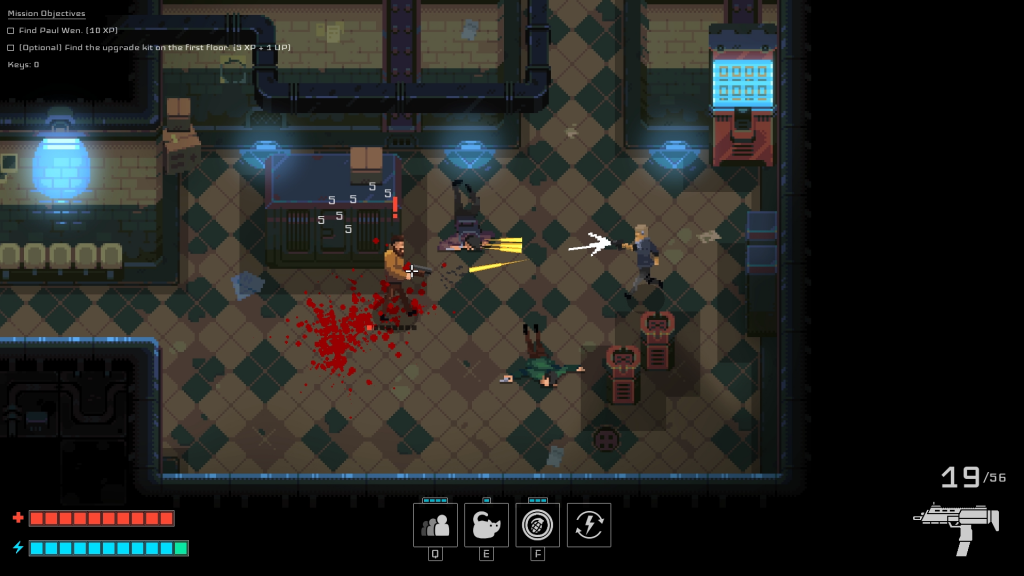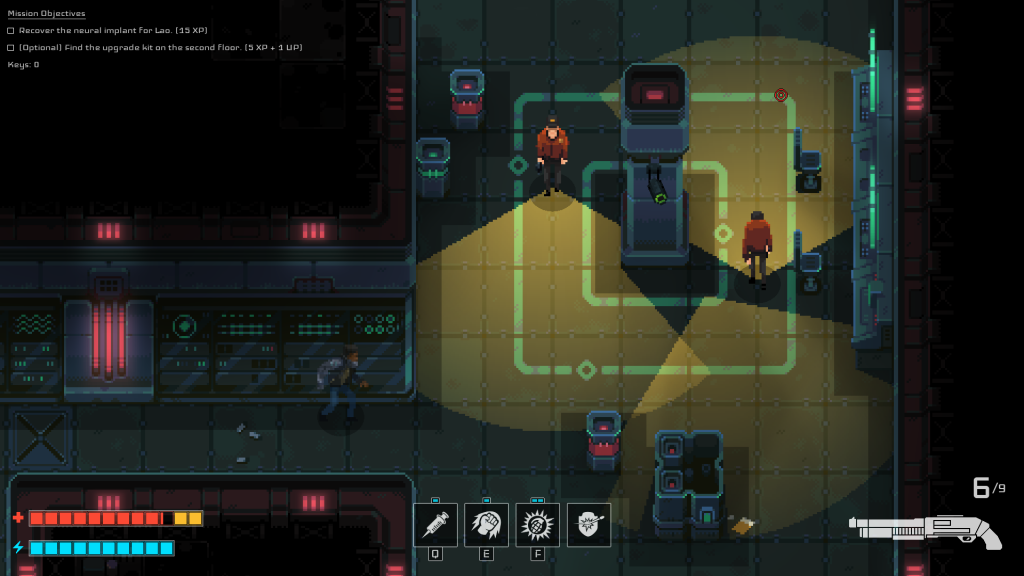There’s way more to this stealth-action RPG than initially meets the eye.
Inadvertently, Cyberpunk 2077’s troubled release served, in our opinion, to highlight a wing of the modern games industry which should be more celebrated than it is: the indie games scene. In recent years, indie games have gone from strength to strength, and it’s not hard to see why. Above all else, their publishers have the great luxury of being able to wait until they are actually finished before putting them on sale.
Created by tiny New York indie developer Ape Tribe games and published by Sold Out, Disjunction is actually a lot more like Cyberpunk 2077 than you might, despite its visual style. It has a cyberpunk vibe, for example, and is indisputably a proper RPG – in which you switch between three characters, whose abilities can be enhanced and added to in such a way as to conform to your chosen play-style, and even has a branching storyline.
Of course, it doesn’t look like the average modern RPG, with its top-down perspective harking back to 16-bit days. But what it lacks in terms of cutting-edge graphics, it more than makes up for by way of playability. It’s one of those games that proves furiously moreish. It’s fairly hard, in a rigorous, old-skool manner, which adds to your compulsion to navigate its levels without setting a single foot wrong.

A dystopian 2048 New York
Dysjunction is set in a mildly dystopian version of New York in 2048 when, in true cyberpunk fashion – all too believable given recent occurrences – any pretence towards good government has gone to pot in favour of private military companies and authoritarian tendencies. Cybernetic enhancement, too, is in evidence, although to a less sophisticated extent than in Cyberpunk 2077.
You start the game as Frank Monroe, a private eye investigating on behalf of his friend Lamar, a community leader from Central City – a shanty for the dispossessed that has been established in Central Park. According to TV reports, Lamar shot a cop and was in possession of a mysterious new drug called Shard when he was arrested.
Stealth-action to the fore
Knowing Lamar has been framed, Frank heads to a lab in Central City looking for evidence, and Disjunction’s gameplay begins to unfold. It’s pretty reminiscent of the first Metal Gear Solid, along with Hotline Miami, mixed with a dash of the original Deus Ex. So you must sneak around, avoiding enemies’ vision-cones, which you can see when you enter stealth mode.
Each of the game’s three characters (Frank, Joe and Spider) have different objects and abilities which augment their sneaking. Frank, for example, has a smoke grenade and a Shock Bolter, which fires a silent projectile that immobilises enemies so Frank can move in for takedowns. Like all the characters, he has a gun – a revolver — while Joe has a shotgun and Spider a submachine gun.
Frank can also heal himself, but all his abilities cost energy; occasionally, enemies you take down will yield energy cells, and the passive ability you can acquire which increases your chances of energy pick-ups proves valuable. Especially if you decide to try going through the game without killing anyone: particularly in the early stages, any dead enemies you leave in your wake can alter the storyline that unfolds.

Familiar but evolving gameplay
Each mission you undertake follows a well-defined pattern: the story is set via a conversation with someone else, before whichever character you’re controlling jumps on a train to an interior location you must sneak around, taking down enemies and dealing with defence drones, switching off security cameras and finding keycards that open up new areas, before ultimately locating the evidence you need to advance the story.
Most of the fun lies in exploring the different characters’ attributes and abilities: Joe, for example, is a boxer with a cybernetic arm, so has a vicious melee attack and extra health, while Spider can temporarily become invisible and generate a holo-projection which attracts and distracts enemies.
Soon, when faced with different types of enemies moving around rooms, you become attuned to their patterns and work out how to take them down one by one. As ever with a stealth game, patience is paramount: trigger an alarm and enemies will rush you, and since all the characters have a limited amount of health, the chances are that they will then take you down. Naturally, the amount of traps, along with their sophistication, ramps up as you progress; clever level-design increasingly throws up situations which initially seem insurmountable, but which prove to be negotiatiable after a bit of head-scratching.
Disjunction isn’t perfect: for example, although most of the control system can be remapped, there’s no way to move the menu containing the objective and map away from the L3 button, with movement also assigned to L3, so especially on a PlayStation 4 controller, with its hair-trigger joystick-clicks, it’s too easy to inadvertently find yourself menu-diving in the most critical situations.
But it’s a classic example of a game that is way deeper than its visual appearance suggests. It may look like a throwback and possess gameplay which is deceptively uncomplicated, but it is actually a proper, surprisingly deep RPG which offers plenty of replayability, especially to those who like to pursue a path of perfection through stealth games.
As long as you aren’t so snobbish that you can’t cope with playing a game that doesn’t boast state-of-the-art 3D visuals, you ought to love Disjunction, particularly if you’re a fan of the stealth-action genre. It’s a classic indie game, in that what it lacks in graphical sophistication, it more than makes up for in the areas that truly count, most notably gameplay.
